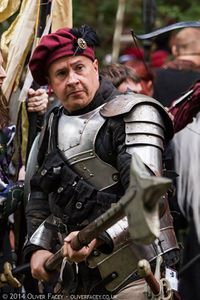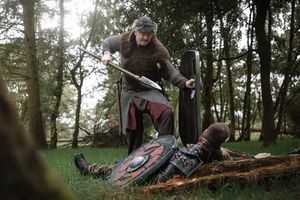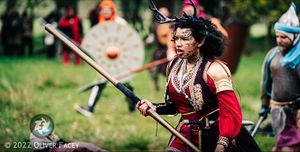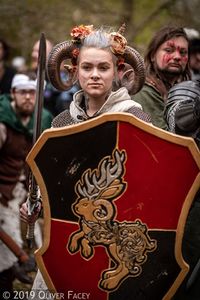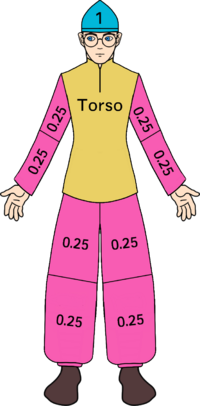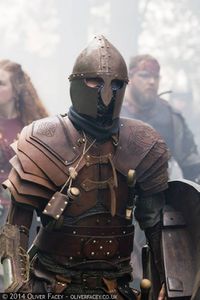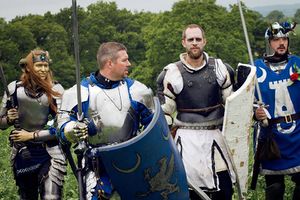Weapons & armour
Weapons
- All weapons must be at least 8” (20 cm) long
- All weapons must be a phys-rep of a weapon
- Some categories require you to use a set grip to fight with the weapon
- All weapons, bows, arrows, shields and armour, must be checked by a member of the Profound Decisions weapon checking team
- Some phys-reps are inappropriate for use in Empire, please check the costume guidelines before you buy
There are six basic weapon categories in Empire. Any character can wield a dagger or a one‑handed weapon but they must purchase the Weapon Master skill to use anything larger. Weapon categories are also important for enchantments. One-handed spears, polearms, and pikes require you to use a set grip when fighting with the weapon. These grips are set for a combination of safety and play balance. You don’t have to carry the weapon like this when you are not fighting, but you must use the mandated grip throughout any fight where you use the weapon.
All weapons in Empire must be a phys-rep of an actual weapon - an object commonly used in battle. LRP-safe versions of common household objects like pans or gardening tools like shovels cannot be used as weapons.
All weapons, bows, arrows, shields and armour, must be checked by a member of the Profound Decisions weapon checking team before they are used at our events. They check every item to ensure that the design, construction and condition of it is suitable for use at our events. If they are not satisfied that an item is safe for use then you must secure the item in the OOC area and may not use it at the event.
Some phys-reps of weapons are inappropriate for use in Empire - for example muskets or bat'leths are not allowed. Some phys-reps can be used but are less appropriate for the game - such as a flaming sword or a crystal mace. The look and feel brief for each nation gives advice on the best phys-reps to use for your character where possible. The costume page provides more detail on kit that is not allowed or better avoided and explains how the limitations work in practice.
Daggers
- Must be between 8” and 24” long
Any character may use a dagger in combat provided it is between 8” and 24” long. The only difference between a dagger and a one-handed weapon is that you cannot use a dagger with any heroic skills or with enchantments suitable for one-handed weapons.
One-handed Weapons
- Must be between 24” and 42” long
Any character may use a one-handed weapon in combat provided it is between 24” and 42” long. Flails up to 42” in length are included in this category and can be used by any character. Larger flails are covered by the rules for great weapons.
Great weapons
- Must be over 42” and up to 60” long
- You must hold the weapon in both hands
Any character with the Weapon Master skill may use a weapon up to 60" long provided they hold it in both hands.
Polearms
- Must be between 60” and 84” long
- You must hold the weapon in both hands with at least 18” separating them
- Can have a thrust-safe tip
Any character with the Weapon Master skill may use a weapon between 60" and 84" long provided you hold the weapon in both hands at all times and keep at least 18 inches separation between your hands during combat. This means that you cannot fight by sliding the polearm back and forth through your hands so that your hands meet - your hands must stay 18 inches apart throughout.
If the weapon has a thrust-safe tip then you may make thrusting strikes with it.
Pike
- Must be over 84” and up to 108” long
- You must hold the weapon in both hands with at least 18” separating them
- Must be a phys-rep of a pike
- Must have a thrust-safe tip and only be used for thrusting
A pike is any phys-rep of a pike that is between 7 foot and 9 foot in length. You must hold the weapon in both hands at all times and have at least 18” separation between your hands during combat. A character must have the Weapon Master skill to wield a pike.
A pike must have a thrust safe tip. You may only thrust using the pike, you may not swing any weapon that is over seven foot in length.
One-handed Spear
- Must be over 60" and up to 84" long
- You must hold the weapon within 6" of the centre of the shaft
- Must be a phys-rep of a spear
- Must have a thrust-safe tip and only be used for thrusting
A one-handed spear must be a phys-rep of a spear which is between 60" and 84" long. The weapon can be wielded in one hand - but you must hold the weapon within 6" of the centre of the shaft during combat. A character must have the Weapon Master skill to wield a spear one-handed in this manner.
A one-handed spear must have a thrust-safe tip and can only be used for thrusting. You cannot swing a weapon of this size when it is held in one hand.
Implements
- Offensive spells can only be delivered using an implement
- Must be a safe phys-rep of a wand, rod or staff
- Should not look like a weapon
- Cannot be used with heroic skills
An implement is a magical tool that allows a magician to deliver an offensive spell. All offensive spells require an implement to be used. You cannot use an implement to deliver a regular spell such as mend or heal.
All implements must be weapon-safe phys-reps. They may appear to be made of any material, and should be decorated and shaped to make it as clear as possible that they are magical implements and not weapons. The ideal phys-rep is a suitably arcane looking rod, staff or wand. You may use a quarterstaff, but you cannot use a spear or anything that is clearly a phys-rep of a weapon.
A character can cause a point of damage with an implement, but they cannot be used with the heroic skills cleaving strike, mortal blow or mighty strikedown.
Implements come in three broad classifications: wands, rods, and staves. Any character with the magician skill can wield a wand or rod effectively, but the Battle Mage skill is needed to wield a staff.
Although any magician may choose to use a wand or rod as an implement, some magical enchantments can only be placed on wands and some can only be placed on rods.
Wands
- Must be between 8” and 18” long
A wand is 8” to 18” long. Magical wands usually enhance healing incantations such as restore limb or utility incantations such as mend
Rods
- Must be over 18” and up to 42” long
A rod is 18” to 42” long. Wielded in one hand, a rod is popular with many magicians who take the battlefield because it can be combined with a shield or with another one-handed weapon (provided the magician possesses the skill to do so). Magical rods most commonly enhance battlefield incantations such as repel or empower.
Staff
- Must be over 42” and up to 84” long
- You must hold the weapon in both hands
- A staff that is at least 60” long must be held in both hands with at least 18” separating them
- Can have a thrust-safe tip
A staff is 42” to 84” long. It must be wielded in two hands, but greatly extends the magician's reach for delivering implement incantations. Staves are popular with magicians of all backgrounds, but require the Battle Mage skill to use in battle. Magic staves may enhance battlefield incantation or grant benefits to ritual casters.
A staff that is between 60" and 84" in length may have a thrust-safe tip. If it does then you may attack, and deliver spells and incantations, by making an appropriately safe thrust to strike your target. You must keep at least 18" separation between your hands when wielding a staff that is 60" or longer.
Bows
- You must have the Marksman skill to use a bow or crossbow
- You must hold the weapon in both hands to shoot
- Participants under 18 years of age cannot use a crossbow
You may use a bow or crossbow. All missile weapons require both hands to shoot and do IMPALE automatically, with no need to call the effect.
Crossbows in Empire can only fire one bolt at a time - you can use a phys-rep crossbow that has more than one channel for a bolt, provided that you do not load more than one bolt at once.
Under UK law, participants under 18 years of age cannot be in possession of a crossbow unless under the supervision of a person who is 21 years of age or older. In terms of our game, this means that we do not permit participants under that age to use crossbows, except when supervised under controlled conditions (Such as a setup archery range, or a teaching session at the Academy).
Thrown Weapons
- You must have the Thrown skill to use a thrown weapon
- Must be 8" or longer and passed by weapons check as safe for throwing
You may throw weapons of 8” or larger provided that it has been passed as safe for throwing. Throwing weapons may include axes and javelins, but you cannot throw shuriken, rocks, or tiny throwing knives shorter than 8” long.
Shields
- Any character can use a buckler up to 15” (40 cm) in diameter
- A shield must be gripped by a handle held in the hand
- Characters with the shield skill can use larger shields
- You can push with a shield, but you cannot shield barge another character
Any character can use a buckler, a small shield up to 15 inches in diameter. If you have the shield skill then you can use a larger shield. The maximum dimensions for a shield are based on the shape, listed in the table below.
A shield must be gripped by a handle held in the hand to protect the wearer. A shield that is simply strapped to the body does not protect the wearer. All blows that strike a slung shield are considered to hit the character wearing it.
Some special calls still effect a character even if the blow is blocked by a shield. A character is still repelled, entangled, or knocked off their feet if the blow strikes their shield, although they do not lose any hits.
| Shield Type | Max Dimensions |
|---|---|
| Buckler | 15" (40cm) diameter |
| Round shield | 40" (1m) diameter |
| Tower shield | 40" by 24" (1m by 60cm) |
| Kite/Heater shield | 48" by 24" (1.2m by 60cm) |
If you are standing still or walking slowly then you may hold a shield out and push with it. You are not allowed to shield barge other characters; you must not run, shield first, into another character for safety reasons.
Armour
- All characters can wear armour
- The phys-rep must be a piece of armour: leather clothing or similar does not count
- Armour that covers the torso and another location provides extra global hits
- Some armour protects from CLEAVE or IMPALE
- Magicians cannot cast spells or perform rituals while wearing armour
Armour protects the wearer by increasing their global hits if it covers the majority of the torso and at least one other location. Complete coverage of the front of the torso is considered sufficient. Valid locations are the head (with a helm), the arms, the legs, or you may cover half of your arms and legs.
E.g. A mail vest covers your torso but does not cover another location. If you wear it with a helm then it would count. A full-length mail hauberk covers the torso, thighs and upper arms so it would always count.
Medium armour protects a character against CLEAVE, while heavy armour protects them against CLEAVE and IMPALE. You are only protected if the blow strikes the armour phys-rep; if it hits an unprotected part of the body then you are affected normally. Your armour continues to protect you in this way even if the hits it provides have been lost.
Any character can wear armour, but magicians cannot cast spells or perform rituals while wearing any armour other than mage armour.
To count as armour, the phys-rep must be a phys-rep of a suit of armour. A leather coat or biker jacket does not count as armour and is not appropriate costume for the Empire setting. Leather armour may count as light or medium armour depending on the thickness; adding studs or rivets does not make it count as heavy armour.
Armour does not provide separate armour hits, it protects you by increasing your global hits. Armour is not repaired separately. Whenever you are healed back to full hits all lost hits are regained. Wearing more than one type of armour does not grant any additional hits.
Helmet
- All characters can wear a helmet
- If the phys-rep is a robust helmet that contains padding that protects your head then your character gains one additional body hit
- A helmet never interferes with spellcasting
A helmet provides additional protection by increasing your global hits by one, provided the phys-rep is a robust helmet that includes padding that will help to protect your head in real life. This means a phys-rep of a helmet that is made from metal, leather, foam or similar material that includes padding that might reasonably provide some real protection to your head if you get a stray head hit. It must be a phys-rep of armour, so an arming cap is the bare minimum - a thin cloth cap, a hat, head-band or similar does not count.
A helmet with no padding, or a mail coif does not count. You can add foam padding to a helm or wear a coif over a padded cap to gain the additional benefits. You can email a picture of your helm to rules@profounddecisions.co.uk if you need a definitive ruling.
A helmet will also count as part of your character's armour, if it increases the amount of cover your armour provides to the necessary limits then you also gain additional hits from your armour as well as one additional hit from your helmet.
Magicians cannot cast spells or perform rituals while wearing any armour, except for a helmet. A helmet never interferes with your spellcasting.
Light Armour
- Padded cloth or thin leather armour (between 1.5mm and 3mm).
- Provides 2 extra hits only.
Any armour made of padded cloth such as a gambeson or light or thin leather such as a thin leather hauberk is classed as light armour. If it covers the torso and one other location it provides the wearer with 2 additional hits. It does not provide any additional protection against heroic blows.
Medium Armour
- Leather or armour made to appear as if constructed from leather.
- Must be 3mm or more thick.
- Provides 3 extra hits and protects against CLEAVE.
- Provides a hero point provided you are not wearing any heavy armour.
Any armour that is made to look like leather armour is classed as medium armour. If it covers the torso and one other location it provides the wearer with 3 extra hits. This can be made of any material that is made to look like leather, but the material used must be 3mm or more thick.
If the armour covers the torso and one other location then it also grants you a hero point. You do not get this benefit if you are wearing heavy armour on any location other than the head.
If the wearer is hit by a CLEAVE heroic blow that strikes a piece of medium armour rather than directly hitting the wearer then the target loses one hit but does not take any additional effects.
Heavy Armour
- Metal armour or armour that looks like it is metal.
- Provides 4 extra hits and protects against CLEAVE and IMPALE
Any metal armour, or any armour designed to look metal is classed as heavy armour. If the armour covers the torso and at least one other location then it provides the wearer with 4 extra hits. This includes polyurethane, foam, aluminium and other lightweight materials, provided the surface is made to look like metal, as well as brigandine armour (armour that looks like metal covered with fabric).
If the wearer is hit by a CLEAVE or IMPALE heroic blow, that strikes a piece of heavy armour rather than directly hitting the wearer then the target loses one hit but does not take any additional effects.
Not Armour
- Some materials can never be used to make light, medium or heavy armour
- This includes cardboard, tinfoil and paper.
- Wool or other fabric coloured to look like chain is also not acceptable.
- If in any doubt about what you're making your armour from, please email rules@profounddecisions.co.uk.
Light-weight flimsy materials such as cardboard, tinfoil and paper cannot be counted as armour in Empire. Wool padding in gambesons and similar is fine, but you cannot use knitted wool or other fabric which is coloured to look like chain as armour either. These materials can be used to make mage armour if desired.
Mage Armour
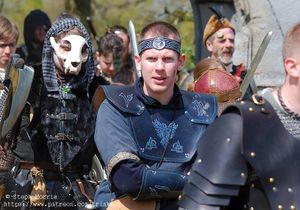
- You must have the battle mage skill to wear mage armour
- Must cover at least 3 locations including one of the chest, shoulders or waist
- Provides 2 extra hits only
- Does not protect against CLEAVE or IMPALE
Mage armour is a magical talisman that protects you against harm but allows you to cast spells and perform rituals. The talisman is made up of several pieces fitted to the wearer's body to protect them. The parts of the talisman superficially resemble pieces of armour, but armour that is ornate and ceremonial rather than practical. They are often decorated with runes, crystals, gems, or other magical accoutrements and it is clear that the armour protects the wearer through magic rather than by physically deflecting blows.
Mage armour provides the wearer with two additional hits. Mage armour does not protect against CLEAVE or IMPALE. To qualify, the mage armour must include three of the following items including at least one of the first three items on the list:
- Pauldrons (shoulders)
- Pectoral (upper chest)
- Hero Belt (waist)
- Circlet or mask (head)
- Vambraces (wrists)
- Gorget (neck)
- Greaves (lower legs)
The items must be substantial and cover a significant portion of the area, but it is possible to use a single pauldron, greave, or vambrace if appropriate for the costume.
You must have the Battle Mage skill to wear and use mage armour. Although mage armour is magical in nature, any character with the battle mage skill is assumed to have access to a suit of mage armour, in the same way a warrior has access to a suit of mundane armour.
Mage armour can be made out of any real-world material, provided you try to make as clear as possible that your character is wearing magical protection and not mundane armour.
Further Reading
- Combat
- Calls
- Weapons & Armour
- Game Items
- Stealing
- Roleplaying Effects
- Rules FAQ
- Rules Summary in A5 and A4
- Weapon checking
